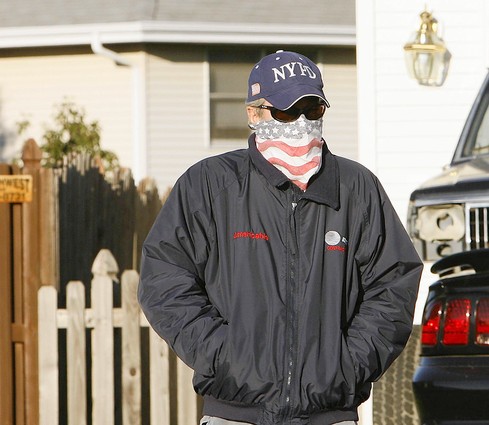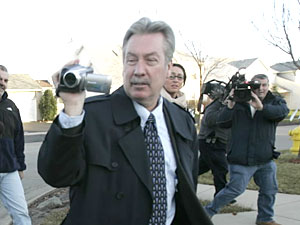The wife of a police sergeant disappears, and stays disappeared. Turns out that she is–or was–his fourth wife, and the third wife had expired in suspicious circumstances, and the cop may have been using police department computers to get information on his (fourth) wife’s friends, and the story gets curiouser and before you know it, he resigns from the force while becoming both a police suspect and the hot story in the Chicago media.
And they say the suburbs are dull.
Even if this guy beats the rap, it’s clear there is much not to like, but that’s his business. My interest in how he has provided a lesson about the visual public sphere. Peterson clearly has adapted quickly and dramatically to the media mob camped outside his house. Here’s where he started:
The caption read: “Bolingbrook Police Sgt. Drew Peterson — whose wife, Stacy, has been missing since Sunday — steps outside his home for a few seconds as police investigators search his home Thursday. Asked about whether he was nervous, Peterson told the Tribune, ‘Why should I be nervous? I did nothing wrong.'”
Now it can get chilly in Chicago in November, but you don’t have to cover your face. I thought of doing a separate post on this photo and calling it “American Burqa.” By bundling up against the media gaze, Peterson is challenging our norms of public visibility. Some of us resist the demand to be seen, as when we wear sun glasses inside or ball caps pulled low, but that is always within the range of legitimate withdrawal into a zone of privacy. As Peterson shows, all you have to do is cover the face itself and your display of autonomy is no longer acceptable. No wonder the guy looks guilty as hell. The picture says, “withholding information, hiding something, and a law onto himself.”
It is easy to conclude that this strategy of hiding in the light is not so smart. But don’t conclude that Peterson is not cagey. The jacket and jeans combo, NYPD ball cap, and flag bandanna scream “selected for symbolic value.” He may not be nervous, but he is trying to put some visual spin on a bad situation.
Turns out that he’s also coachable. I’m speculating here, but I’ll bet he got a lawyer and some help on the presentation of self in public. Because this is what we saw more recently:
Whoa! Is that the suspect or his lawyer? Comfortably striding along in middle class attire, he turns his video camera on the press. Instead of denying the norm of public visibility, he ramps it up, creating a hypervisual scene of cameras recording cameras recording cameras. Instead of passively hiding in full view of an unseen camera, he aggressively records the press, thereby bringing them into the picture. Instead of looking isolated and guilty, he declares that he has nothing to hide while the press is unfairly ganging up on him.
He’s catching on, isn’t he? This is what conservative politicians and media flacks have been doing for years: shifting the focus from their actions to the media coverage, which then is denounced as excessive and unfair. You can’t paint Peterson completely with that brush, however, as his brash act has another, more distinguished lineage. This includes Garry Winogrand, a photographer who focused his camera on the technologies of media coverage (see his 1977 book, Public Relations), and, behind him, Walter Benjamin’s argument that photographic artifice depends on hiding the equipment. By exposing the cameras trained on him, Peterson has not only adopted a sophisticated strategy for deflecting the gaze, but also activated a more reflexive awareness of the role of photojournalism in shaping the story.
Even so, I think he still looks guilty as hell. It’s probably the smile. . . .
Chicago Tribune photographs by Antonio Perez (November 1, 2007) and Terrence Antonio James (November28, 2007). Thanks to Elisabeth Ross for reminding me of Winogrand’s work, which was included in her presentation on “Private Eyes and Public Lives” at the recent Northwestern University conference on Visual Democracy.


It’s probably going from one extreme guise to the other that makes him look guilty. If he had started somewhere in between Masked Man and Media Outrage and stuck there, he’d have a better chance. We in the public sphere can sometimes see baloney for what it is.
The problem with baloney is that it is hard to see. If all the public world is a space of performance, then the appearance of “innocence” can only be another act. There is no doubt that this guy is a sophisticated public performer, wise to the ways of visual impression. But guilt?
It is, I suspect, the story of the circumstances and not the visual imagery that lead us to impute guilt.
[…] an interesting post today on Dueling Cameras in the Peterson CaseHere’s a quick […]
I agree that in the first photo this guy is protecting his privacy from the obsessive gaze of the media mob but I think that he is really responding to the fact that at that moment he has no privacy in his own home. Teams of police are rooting through his closets and snooping in his underwear drawer. The difference in the two photos is that in the first he has no control over his private space and in the second he offers a well rehearsed presentation of himself as someone who has control of his private life and of who sees what.
I’m not sure why I find these images both repulsive and intriguing. Normally, I go out of my way to avoid reading, knowing, or acknowledging in any way, this sort of nasty non-news story. In this case, I find myself actually following the story; I’m sure it is due in part to it being impossible to avoid if you live in America, but part of it has to do w/the bizarre imagery, and the creeps apparent manipulation of it.
Is the guy conciously adept @ manipulating the imagery, or is it a natural outgrowth of his apparent weirdness, i.e., is he acting out bizarre behaviors because he’s nuts?
Either way, I find myself embarassed even talking about it, but have to admit, it’s non-news that I find myself contemplating. Is that due to imagery alone?
Ideology is wrong questions about important things; what this guy did, and the coverage of him matters, but not in the terms the media provides. The key question isn’t “is he guilty?” but “why does this news matter to people?” I refuse to believe in non-news – the news is the news coverage itself. And that’s what the second image does – cameras performatively create an object of interest, they draw attention by pointing. He’s re-coding the coverage as the real event, rather than letting the cameras define the event unchallenged.
He probably looks guilty also because the camera-gesture just seems so schoolyard petty. To the degree that the media coverage itself is accusatory, turning the camera around (counter-charging) when he’s up for murder makes it seem almost like a desperate distraction. The privacy violation claim just seems so small compared with a life-violation claim. (Also, remember the CIA tapes non-visual event: we live in an age where protecting privacy increasingly looks like a cover for guilt)
Duncan
Anyways.